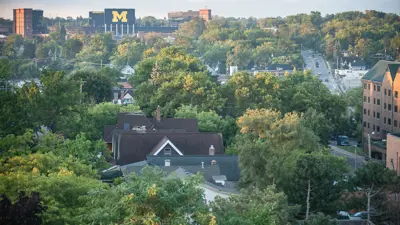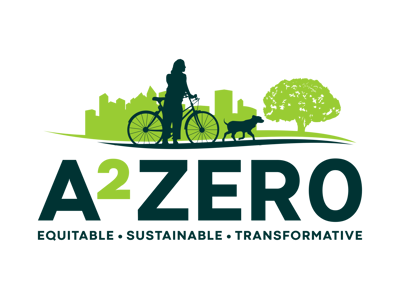Ann Arbor Home Energy Rebates
The Ann Arbor Home Energy Rebates can be used for a variety of items, including heat pumps, heat pump water heaters, induction cooktops and ranges, and insulation, among others. Rebate amounts reset annually.
DTE Energy Efficiency Rebates
DTE offers rebates for multiple energy efficient appliances, including washers and dryers, windows and doors, insulation, Wi-Fi thermostats, and more. The rebate amount varies based on the appliance, building, and existing systems in the building. Depending on the account structure with DTE, property owners might need to work with tenants who are the account holder to access the rebates.
DTE Multifamily Program
The DTE Multifamily Program is an energy efficiency initiative designed to help multifamily buildings, defined as a property with three or more units under one roof, reduce energy usage and cost. Property owners can request a free energy assessment to determine which energy-saving options are applicable and get assistance in selecting upgrades. Properties are eligible for $100,000 in total incentives per property per year, with increased incentives for properties that are income qualified.
DTE Strategic Energy Management Program (SEM)
SEM is designed to help large commercial and industrial customers continuously improve their energy performance and reduce energy waste. DTE offers technical support and financial incentives to qualified customers.
Investment Tax Credit
The Investment Tax Credit reduces the federal income tax liability for a percentage of the cost of a solar or geothermal system that is installed during the tax year. Installed systems are eligible for a 30% tax credit if the project meets labor requirements and are eligible for an additional 10% for projects that meet a domestic content minimum, 10% if the project is located in an energy community, 10% if the project is located in a low-income community, and 20% if the project is on a qualified low-income residential building or qualified low-income economic benefit project. Note, projects can either qualify for the Investment Tax Credit OR the Production Tax Credit, so it is important to review which option works best for your project. In general, the U.S. Department of Energy says smaller-scale solar projects receive more value utilizing the Investment Tax Credit. However, this can change over time and be dependent on the system being installed.
Market to Market Program
The U.S. Department of Housing and Urban Development's Market-to-Market program preserves affordability and availability of low-income rental multifamily properties with federally insured program by restructuring debts to levels supportable by reduced rents. The program also includes a Green Initiative to assist owners in rehabilitating their properties in the most sustainable way feasible. To participate, property owners must have four or more dwelling units covered in whole or in part by a project-based Section 8 rental housing assistance contract among other similar requirements.
Michigan Saves
Michigan Saves is Michigan's green bank and provides affordable financing for energy efficiency, renewable energy, diversification, and carbon reduction projects for both residential homes and commercial buildings. Michigan Saves partners with lenders to negotiate the best rates for projects while also connecting projects to qualified contractors ready to take on the work.
Property Assessed Clean Energy (PACE) Financing
PACE is a financing tool that enables cash flow positive investments in comprehensive energy efficiency, water efficiency and renewable energy projects. Through PACE financing, property owners can eliminate the need for upfront capital and spread the costs over a period up to 25 years, allowing the savings generated from the project to cover the loan repayment with the excess savings resulting in an immediate positive cash flow. Lean and Green Michigan is the administrator for PACE in Michigan.
Production Tax Credit
The Production Tax Credit is a per kilowatt-hour tax credit for electricity generated by solar and other qualifying technologies for the first 10 years of a system's operation. Installed systems are eligible for 2.75 ¢/kWh if they meet project labor requirements and are eligible for an additional 0.3 ¢/kWh for projects that meet a domestic content minimum and 0.3 ¢/kWh if the project is located in an energy community. Note, projects can either qualify for the Investment Tax Credit OR the Production Tax Credit, so it is important to review which option works best for your project. In general, the U.S. Department of Energy says smaller-scale solar projects receive more value utilizing the Investment Tax Credit. However, this can change over time and be dependent on the system being installed.
Tax Credit – 179D
The 179D energy efficiency tax deduction enables building owners to claim a tax deduction for installing qualifying systems in buildings. Previously, multifamily buildings did not qualify for this deduction, but under the Inflation Reduction Act, multifamily buildings that are at least four stories tall are now eligible both for new builds and retrofits. The deduction is the lesser of the cost of the installed property or the savings per foot calculated as $0.50 per square foot for a building with 25% energy savings, plus $0.02 per square foot for each percentage point of energy savings above 25% up to a maximum of $1 per square foot for a building with 50% energy savings. If local prevailing wages are paid and apprenticeship requirements are met, an increased maximum deduction applies, with the maximum amount increasing to five times the savings per square foot amount.
Tax Credit – 45L
The 45L tax credit provides a tax credit for eligible new or substantially reconstructed homes that meet applicable ENERGY STAR home program or DOE Zero Energy Ready Home (ZERH) program requirements. The 45L credit is $5,000 for dwelling units that are part of a building eligible to participate in the ENERGY STAR Multifamily New Construction Program, are certified to applicable ZERH program requirements, and meet prevailing wage requirements. If prevailing wage requirements are not met the credit is $1,000 per dwelling unit.
Weatherization Assistance Program
The Weatherization Assistance Program helps reduce energy costs for low-income households by increasing the energy efficiency of their homes, while ensuring their health and safety and safety. Multifamily and rental properties can qualify for this program if at least 66 percent, or 50 percent for duplexes and four-unit buildings, of the tenants qualify as low-income.


